1. PT100 and PT1000 temperature resistance change table
Metāla termiskie rezistori, piemēram, niķelis, Vara un platīna rezistoriem ir pozitīva korelācija ar pretestības izmaiņām ar temperatūru. Platīnam ir visstabilākās fizikālās un ķīmiskās īpašības, un tas ir visplašāk izmantotais. Parasti izmantotā platīna rezistora PT100 temperatūras mērījumu diapazons ir -200 ~ 850 ℃. Papildus, PT500 temperatūras mērīšana, PT1000, utt.. ir secīgi samazināti. PT1000, Temperatūras mērījumu diapazons -200 ~ 420 ℃. Saskaņā ar IEC751 starptautisko standartu, Platīna rezistora PT1000 temperatūras raksturlielumi atbilst šādām prasībām:
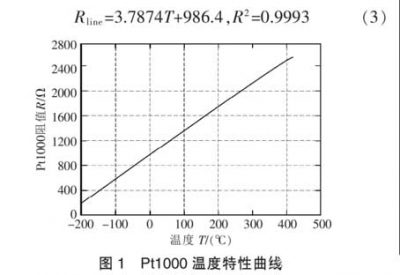
PT1000 temperatūras raksturīgā līkne
Saskaņā ar PT1000 temperatūras raksturīgo līkni, the slope of the resistance characteristic curve changes little within the normal operating temperature range (Kā parādīts attēlā 1). Through linear fitting, the approximate relationship between resistance and temperature is:
1.1 PT100 temperatūras pretestības maiņas tabula
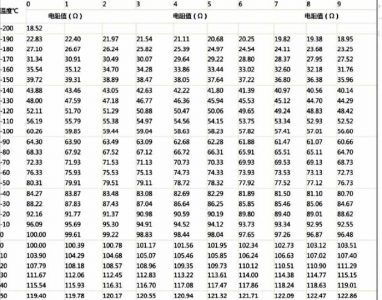
PT100 temperatūras pretestības maiņas tabula
1.2 PT1000 temperature resistance change table
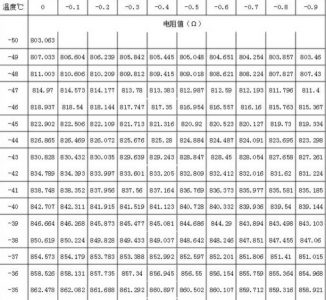
PT1000 Temperature Resistance Change Table
2. Parasti lietoti iegūšanas shēmas risinājumi
2.1 Resistor voltage division output 0~3.3V/3V analog voltage
Single-chip AD port direct acquisition
Temperatūras mērīšanas ķēdes sprieguma izejas diapazons ir 0 ~ 3,3 V, PT1000 (Pt1000 pretestības vērtība ievērojami mainās, temperature measurement sensitivity is higher than PT100; PT100 ir piemērotāks liela mēroga temperatūras mērīšanai).
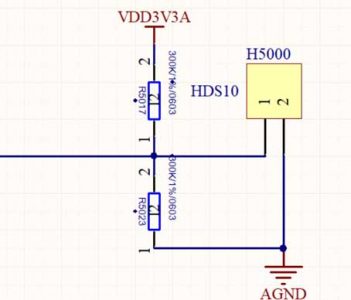
Resistor voltage divider outputs 0~3.3V 3V analog voltage
Vienkāršākais veids ir izmantot sprieguma dalīšanas metodi. The voltage is the voltage reference source 4V generated by the TL431 voltage reference source chip, or REF3140 can be used to generate 4.096V as the reference source. The reference source chips also include REF3120, 3125, 3130, 3133, un 3140. The chip uses SOT-32 package and 5V input voltage. Izejas spriegumu var izvēlēties atbilstoši nepieciešamajam atsauces spriegumam. Protams, according to the normal voltage input range of the MCU AD port, tas nevar pārsniegt 3V/3,3V.
2.2 Resistor voltage division output 0~5V analog voltage MCU AD port direct acquisition.
Protams, some circuits use 5V MCU power supply, and the maximum operating current of PT1000 is 0.5mA, so appropriate resistance value should be used to ensure the normal operation of the components.
Piemēram, the 3.3V in the voltage division schematic diagram above is replaced with 5V. The advantage of this is that the 5V voltage division is more sensitive than 3.3V, and the acquisition is more accurate. Atcerēties, Teorētiskais aprēķinātais izejas spriegums nevar pārsniegt +5V. Citādi, it will cause damage to the MCU.
2.3 Visbiežāk izmantotais tilta mērījums
R11, R12, R13 and Pt1000 are used to form a measuring bridge, kur r11 = r13 = 10k, R12=1000R precision resistors. Ja PT1000 pretestības vērtība nav vienāda ar R12 pretestības vērtību, the bridge will output a mV-level voltage difference signal. Šo sprieguma starpības signālu pastiprina ar instrumenta pastiprinātāja ķēdi un izvada vēlamo sprieguma signālu. This signal can be directly connected to the AD conversion chip or the AD port of the microcontroller.
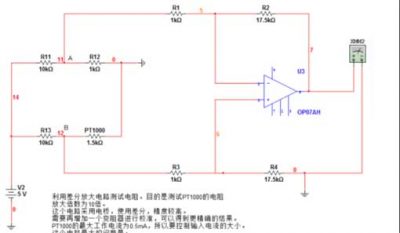
R11, R12, R13 and Pt1000 are used to form a measurement bridge
Šīs ķēdes pretestības mērīšanas princips:
1) PT1000 ir termistors. Kad temperatūra mainās, the resistance changes basically linearly.
2) Pie 0 grādi, Pt1000 pretestība ir 1kΩ, Tad ub un ua ir vienādi, tas ir, Uba = ub – Do = 0.
3) Pieņemot, ka noteiktā temperatūrā, Pt1000 pretestība ir 1,5 kΩ, Tad ub un ua nav vienādi. According to the voltage division principle, we can find out that Uba = Ub – Darīt > 0.
4) OP07 ir operatīvais pastiprinātājs, and its voltage gain A depends on the external circuit, kur a = r2/r1 = 17.5.
5) OP07 = UBA izejas spriegums UO * Izšķirt. Tātad, ja mēs izmantojam voltmetru, lai izmērītu OP07 izejas spriegumu, mēs varam secināt UAB vērtību. Tā kā UA ir zināma vērtība, Mēs varam tālāk aprēķināt UB vērtību. Tad, using the voltage division principle, Mēs varam aprēķināt PT1000 īpašo pretestības vērtību. Šo procesu var sasniegt, aprēķinot programmatūru.
6) Ja mēs zinām PT1000 pretestības vērtību jebkurā temperatūrā, we only need to look up the table based on the resistance value to know the current temperature.
2.4 Pastāvīgs strāvas avots
Sakarā ar termiskā rezistora pašsildojošo iedarbību, the current flowing through the resistor should be as small as possible. Vispārīgi, the current is expected to be less than 10mA. Tika pārbaudīts, vai platīna rezistora PT100 pašsildīšana 1 mW will cause a temperature change of 0.02-0.75℃. Tāpēc, reducing the current of the platinum resistor PT100 can also reduce its temperature change. Lai arī, Ja strāva ir pārāk maza, tas ir jutīgs pret trokšņa traucējumiem, so the value is generally 0.5-2 maiņa, Tātad pastāvīgā strāvas avota strāva tiek izvēlēta kā 1MA nemainīga strāvas avots.
The chip is selected as the constant voltage source chip TL431, and then converted into a constant current source using current negative feedback. Shēma ir parādīta attēlā
Starp tiem, the operational amplifier CA3140 is used to improve the load capacity of the current source, un izejas strāvas aprēķina formula ir:
The resistor should be a 0.1% precizitātes rezistors. Galīgā izejas strāva ir 0,996 mA, tas ir, precizitāte ir 0.4%.
Pastāvīgajai strāvas avota ķēdei jābūt šādām īpašībām
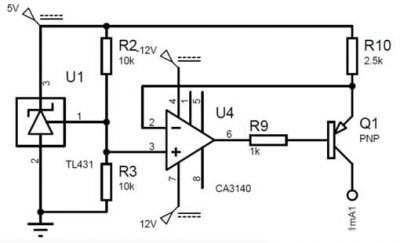
Select the constant voltage source chip TL431
Temperatūras stabilitāte: Tā kā mūsu temperatūras mērīšanas vide ir 0–100 ℃, Strāvas avota izvadei nevajadzētu būt jutīgai pret temperatūru. The TL431 has an extremely low temperature coefficient and low temperature drift.
Labas slodzes regulēšana: Ja pašreizējā pulsācija ir pārāk liela, tas izraisīs lasīšanas kļūdas. Saskaņā ar teorētisko analīzi, since the input voltage varies between 100-138.5mV, un temperatūras mērījumu diapazons ir 0–100 ℃, Temperatūras mērīšanas precizitāte ir ± 1 grāds pēc Celsija, Tātad izejas spriegumam vajadzētu mainīties par 38,5/100 = 0,385 mV par katru 1 ℃ apkārtējā temperatūras paaugstināšanos. Lai pārliecinātos, ka strāvas svārstības neietekmē precizitāti, Apsveriet ekstrēmāko gadījumu, pie 100 grādi pēc Celsija, PT100 pretestības vērtībai jābūt 138,5R. Tad strāvas pulsācijai jābūt mazākai par 0,385/138,5 = 0,000278MA, tas ir, the current change during the load change should be less than 0.000278mA. Faktiskajā simulācijā, Pašreizējais avots galvenokārt paliek nemainīgs.
3. AD623 iegūšanas shēmas risinājums
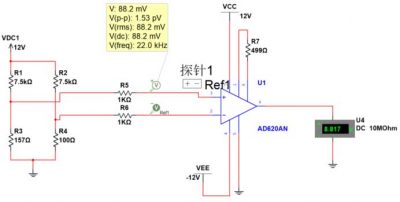
AD623 acquisition PT1000 circuit solution
Princips var attiekties uz iepriekš minēto tilta mērīšanas principu.
Zemas temperatūras iegūšana:
Augstas temperatūras iegūšana
4. AD620 iegūšanas shēmas risinājums
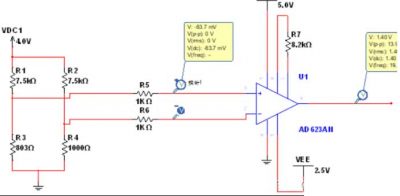
AD620 PT100 acquisition solution
AD620 PT100 acquisition solution high temperature (150°):
AD620 PT100 acquisition solution low temperature (-40°):
AD620 PT100 acquisition solution room temperature (20°):
5. PT100 and PT1000 anti-interference filtering analysis
Temperatūras pieaugums kādā kompleksā, skarba vai īpaša vide tiks pakļauta lielai iejaukšanās, galvenokārt ieskaitot EMI un REI.
Piemēram, Motora temperatūras iegūšanas lietošanā, motor control and high-speed rotation of the motor cause high-frequency disturbances.
Aviācijas un kosmosa transportlīdzekļu iekšpusē ir arī liels skaits temperatūras kontroles scenāriju, kas mēra un kontrolē energosistēmu un vides kontroles sistēmu. Temperatūras kontroles kodols ir temperatūras mērīšana. Tā kā termistora izturība var mainīties lineāri ar temperatūru, Platīna izturības izmantošana temperatūras mērīšanai ir efektīva augstas precizitātes temperatūras mērīšanas metode. Galvenās problēmas ir šādas:
1. Pretestība uz svina stieples tiek viegli ieviesta, tādējādi ietekmē sensora mērījumu precizitāti;
2. In some strong electromagnetic interference environments, the interference may be converted into DC output after rectification by the instrument amplifier
Offset error, ietekmē mērījumu precizitāti.
5.1 Aerospace Airborne PT1000 iegūšanas shēma
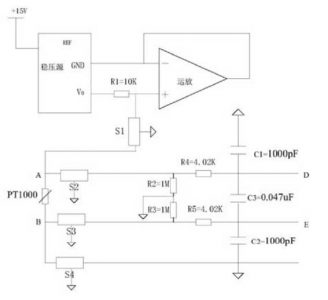
Aerospace Airborne PT1000 iegūšanas shēma
Skatiet anti-elektromagnētisko iejaukšanos noteiktā aviācijā ar gaisā esošu PT1000 iegūšanas ķēdes dizainu pret elektromagnētiskiem traucējumiem.
Iegūšanas ķēdes galotnē ir iestatīts filtrs. The PT1000 acquisition preprocessing circuit is suitable for anti-electromagnetic interference preprocessing of airborne electronic equipment interface;
The specific circuit is:
+15 V ieejas spriegums tiek pārveidots par +5 V augstas precizitātes sprieguma avotu, izmantojot sprieguma regulatoru, and the +5V high-precision voltage source is directly connected to the resistor R1.
The other end of the resistor R1 is divided into two paths, viens savienots ar OP ampas fāzes ievadi, and the other connected to the PT1000 resistor A end through the T-type filter S1. OP amp izvade ir savienota ar apgriezto ieeju, veidojot sprieguma sekotāju, un apgrieztā ieeja ir savienota ar sprieguma regulatora zemes portu, lai pārliecinātos, ka spriegums fāzes ieejā vienmēr ir nulle. Pēc tam, kad esat izgājis cauri S2 filtram, Pt1000 rezistora viens gals ir sadalīts divos ceļos, one path is used as the differential voltage input terminal D through resistor R4, and the other path is connected to AGND through resistor R2. Pēc tam, kad esat izgājis cauri S3 filtram, Otrs PT1000 rezistora gals ir sadalīts divos ceļos, one path is used as the differential voltage input terminal E through resistor R5, and the other path is connected to AGND through resistor R3. D un E ir savienoti caur kondensatoru C3, D ir savienots ar AGND, izmantojot kondensatoru C1, un E ir savienots ar AGND, izmantojot kondensatoru C2; the precise resistance value of PT1000 can be calculated by measuring the differential voltage between D and E.
+15 V ieejas spriegums tiek pārveidots par +5 V augstas precizitātes sprieguma avotu, izmantojot sprieguma regulatoru. +5V ir tieši savienots ar R1. Otrs R1 gals ir sadalīts divos ceļos, one is connected to the in-phase input terminal of the op amp, and the other is connected to the PT1000 resistor A through the T-type filter S1. OP amp izvade ir savienota ar apgriezto ieeju, veidojot sprieguma sekotāju, un apgrieztā ieeja ir savienota ar sprieguma regulatora zemes portu, lai pārliecinātos, ka apgrieztā ieejas spriegums vienmēr ir nulle. Šajā laikā, strāva, kas plūst caur R1, ir nemainīga 0,5 mA. Sprieguma regulators izmanto AD586TQ/883B, un OP AMP izmanto OP467A.
Pēc tam, kad esat izgājis cauri S2 filtram, Pt1000 rezistora viens gals ir sadalīts divos ceļos, viens caur rezistoru R4 kā diferenciālā sprieguma ieejas gals D, un vienu caur rezistoru R2 līdz Agnd; after passing through the S3 filter, Otrs PT1000 rezistora gals ir sadalīts divos ceļos, viens caur rezistoru R5 kā diferenciālā sprieguma ieejas gals E, un vienu caur rezistoru R3 līdz Agnd. D un E ir savienoti caur kondensatoru C3, D ir savienots ar AGND, izmantojot kondensatoru C1, un E ir savienots ar AGND, izmantojot kondensatoru C2.
R4 un R5 izturība ir 4,02K omi, R1 un R2 izturība ir 1 m omi, C1 un C2 kapacitāte ir 1000pf, un C3 kapacitāte ir 0,047UF. R4, R5, C1, C2, un C3 kopā veido RFI filtru tīklu, which completes the low-pass filtering of the input signal, and the objects to be filtered out include the differential mode interference and common mode interference carried in the input differential signal. Parastā režīma traucējumu un diferenciālā režīma traucējumu, kas pārnesti ieejas signālā pārnesti –3dB robežas frekvences aprēķins, tiek parādīts formulā.:
Pretestības vērtības aizstāšana aprēķinā, Parastā režīma nogriešanas frekvence ir 40kHz, un diferenciālā režīma nogriešanas frekvence ir 2,6 kHz.
B gala punkts ir savienots ar Agnd caur S4 filtru. Starp tiem, Filtra zemes spailes no S1 līdz S4 ir savienotas ar gaisa kuģa ekranēšanas zemi. Tā kā strāva, kas plūst caur PT1000, ir zināms 0,05 mA, Precīzu PT1000 pretestības vērtību var aprēķināt, izmērot diferenciālo spriegumu abos D un E galos.
S1 līdz S4 Izmantojiet T veida filtrus, Modelis GTL2012X - 103T801, with a cutoff frequency of 1M±20%. Šī ķēde iepazīstina ar zemas caurlaides filtriem ārējās interfeisa līnijās un veic RFI filtrēšanu uz diferenciālā sprieguma. Kā priekšapstrādes shēma PT1000, Tas efektīvi novērš elektromagnētisko un RFI starojuma traucējumus, kas ievērojami uzlabo savākto vērtību ticamību. Papildus, Spriegumu tieši mēra no abiem PT1000 rezistora galiem, Kļūdas novēršana, ko izraisa svina pretestība, un uzlabot pretestības vērtības precizitāti.
5.2 T veida filtrs
T tipa filtrs sastāv no diviem induktoriem un kondensatoriem. Abiem tā galiem ir augsta pretestība, un tā ievietošanas zaudējumu rādītājs ir līdzīgs π tipa filtra darbam, Bet tas nav pakļauts “zvana” un to var izmantot pārslēgšanas shēmās.
 English
English Afrikaans
Afrikaans العربية
العربية বাংলা
বাংলা bosanski jezik
bosanski jezik Български
Български Català
Català 粤语
粤语 中文(简体)
中文(简体) 中文(漢字)
中文(漢字) Hrvatski
Hrvatski Čeština
Čeština Nederlands
Nederlands Eesti keel
Eesti keel Suomi
Suomi Français
Français Deutsch
Deutsch Ελληνικά
Ελληνικά हिन्दी; हिंदी
हिन्दी; हिंदी Magyar
Magyar Bahasa Indonesia
Bahasa Indonesia Italiano
Italiano 日本語
日本語 한국어
한국어 Latviešu valoda
Latviešu valoda Lietuvių kalba
Lietuvių kalba македонски јазик
македонски јазик Bahasa Melayu
Bahasa Melayu Norsk
Norsk پارسی
پارسی Polski
Polski Português
Português Română
Română Русский
Русский Cрпски језик
Cрпски језик Slovenčina
Slovenčina Slovenščina
Slovenščina Español
Español Svenska
Svenska ภาษาไทย
ภาษาไทย Türkçe
Türkçe Українська
Українська اردو
اردو Tiếng Việt
Tiếng Việt
